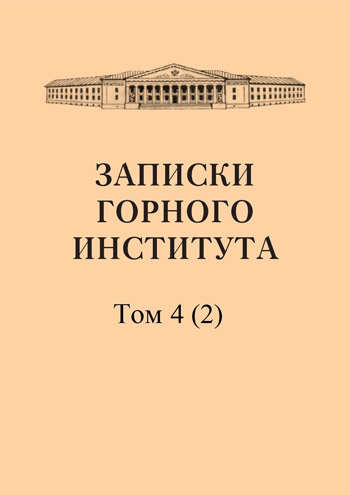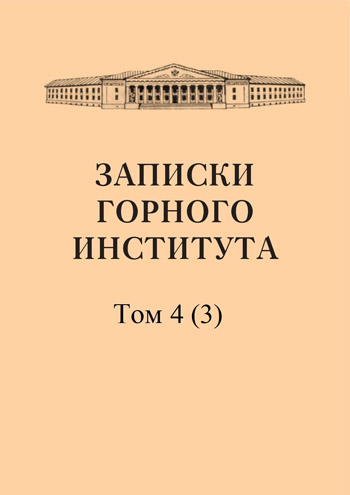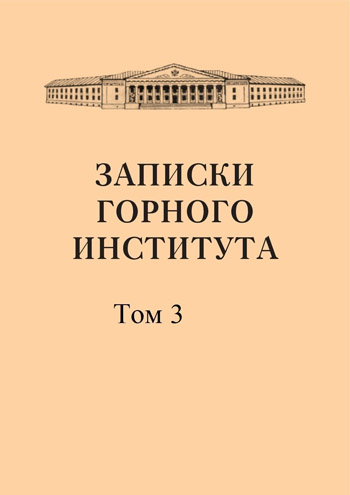-
Date submitted1912-06-28
-
Date accepted1912-08-07
-
Date published1913-02-25
To the concept of a definite integral and the proof of the main theorem for the existence of an integral of ordinary differential equations
- Authors:
- N. M. Krylov
Integrable functions also include functions whose discontinuities can be contained in intervals, and the sum of the extension of the latter is an arbitrarily small value; in fact, by enclosing the discontinuity points in intervals, we can represent the difference (b - a) as the sum of two parts of which the first refers to intervals that, in turn, lie inside the intervals enclosing the discontinuity points (see article). It is enough to show that the difference (b - a) can be made arbitrarily small only under one, well-defined division law, then we can take division points that coincide with the ends of the intervals containing discontinuities in the function f and then the difference (b - a) will actually be as samll as you can imagine. From here we conclude that integrable functions include, among others, functions that have a finite number of discontinuities, as well as functions whose discontinuity points, being infinite in number, have a finite number of so-called limit points.
-
Date submitted1912-07-22
-
Date accepted1912-09-22
-
Date published1913-02-25
On the organization of joint work in the Laboratory of Physical Chemistry of the Mining Institute
- Authors:
- P. P. Von-Weymarn
Scientific research carried out jointly by several individuals always gives rise to rumors about the degree of participation of individual researchers in the overall work, and often these rumors take on a very unpleasant character. To avoid the latter, I consider it necessary to note that in works published jointly on behalf of myself and my students, both the topic and the plan for its development belong to me. Preparatory work, such as preparing solutions, determining and calculating their concentration, analysis, etc., is carried out entirely by my employees.
-
Date submitted1912-06-29
-
Date accepted1912-08-27
-
Date published1913-02-25
About dispersoid chemistry of copper chloride in benzene
- Authors:
- P. P. Von-Weymarn
- I. B. Kagan
In this study, the preparation conditions and some properties of the following disperse systems were studied: No.1. Dispersed systems with a liquid dispersed phase xH2O + yHCl. No.2. Dispersed systems with a solid dispersed phase of CuCl2 composition. No.3. Dispersed system with a solid dispersed phase of composition xH2O + yHCl * H2O. No.4. Dispersed systems with solid dispersed phase CuCl2 * 2N20. No.5. Dispersed systems with solid dispersed phase CuC12. 2H20 and a complex liquid dispersed phase of the composition (see article). No.6. Dispersed systems with a liquid dispersed phase of the composition (see article). No.7. Dispersed systems with a solid dispersed phase of composition (xH2O + y.cupric oleate). No.8. Dispersed systems with a solid dispersed phase of the composition (see article).
-
Date submitted1912-07-16
-
Date accepted1912-10-08
-
Date published1913-02-25
Development and current state of the doctrine of colloids
- Authors:
- B. V. Byzov
Colloids play such an important role in life (indeed, it can be said without exaggeration that up to 90% of the bodies around us are colloids), that it is not surprising if even in the most distant eras we discover familiarity with the processes occurring in colloidal systems. My task is to outline the development of colloidal chemistry and the currently dominant views in it, and in view of the abundance of material I will have to dwell only on the most prominent places.
-
Date submitted1912-09-21
-
Date accepted1912-12-02
-
Date published1913-02-25
Electrical sputtering techniques
- Authors:
- M. Kucherov
The subject of this brief essay will be methods for producing dispersed phases using electrical energy. Electrical methods, which make it possible to obtain dispersoid solutions of mainly elementary, simple bodies—metals and metalloids, can be divided into two groups: the first group includes a few cases of sputtering observed during the cathodic and anodic polarization of some metals in water or aqueous solutions of electrolytes, the second group constitute the most common and practical methods of atomization using spark and arc discharge.
-
Date submitted1912-08-30
-
Date accepted1912-10-04
-
Date published1913-02-25
Crystallization method for obtaining dispersed systems and factors of their stability in connection with the theory of solutions of solids in liquids
- Authors:
- P. P. Von-Weymarn
The article discusses the issues of obtaining a dispersoid solution of low concentration, significant concentration for any substance, as well as the problem of crystallization of colloids; obtaining crystalline substances in a colloidal state; dynamic processes within a dispersion medium as stability factors, stability theorems for dispersoid solutions; dynamic and static chemical compounds, etc.
-
Date submitted1912-06-24
-
Date accepted1912-08-25
-
Date published1913-02-25
New taxonomy of aggregate states of matter and the basic law of dispersoidology
- Authors:
- P. P. Von-Weymarn
The article examines the vectoriality of molecular forces of attraction and clarifies the issue of changing the nature and degree of orientation of molecules. The author draws conclusions: 1. Matter is vectorial in all its states of aggregation. 2. By increasing the degree of dispersion of any solid crystalline substance, you can change the degree of its overall orientation; moreover, at extremely high degrees of dispersion, the resulting crystalline systems are practically indistinguishable from liquids in terms of orientation. Further, the work highlights: the gaseous-liquid crystalline state of matter and its universality; taxonomy and nomenclature of various types of vectorial state of matter; the basic law of dispersoidology and its application.
-
Date submitted1912-07-02
-
Date accepted1912-09-25
-
Date published1913-02-25
Hyperbolic system
- Authors:
- E. S. Fedorov
If we take into consideration only a plane on one side, and a homological hyperboloid on the other, then even in this case we can recognize the relatedness of these linear seconds of points, because the infinitely distant points of the first system, and therefore their complete linear example, are homologous to the points of the straight line of intersection of the hyperboloid with the plane of involution, and consequently this entire straight line as a linear element of extraelements. From here, in particular, it follows that if three arbitrary points are given in the second system, then the spheroprim defined by them can easily be obtained in this way: we project these three points through the center Z onto the plane, construct a circle based on them, and transfer the points of the latter to a parabolic hyperboloid by inverse projection . The center of this spheroprim is also designed. It is clear that this center on the hyperboloid in relation to the spheroprim is the pole of the mentioned straight line on the hyperboloid.
-
Date submitted1912-08-28
-
Date accepted1912-12-20
-
Date published1913-02-25
Crystallographic study of similar sulfo-antimony compounds of Co and Ni
- Authors:
- D. N. Artem'ev
Artificial Ullmanite NiSbS. A compound corresponding in chemical composition to the mineral ulmanite was obtained by Prof. N. S. Kurnakov and Art. J. Posternak (at the St. Petersburg Polytechnic Institute) and transferred to the Mineralogical Institute of the Mining Institute for crystallographic research. CoSbS compound. This compound was obtained (as well as NiSbS) by stud. I. Posternak, was given to me by Prof. N. S. Kurnakov. The walls of the voids in the alloy were dotted with irregularly arranged, thin-plate-like crystals with a strong metallic luster of steel-gray color.
-
Date submitted1912-07-13
-
Date accepted1912-11-25
-
Date published1913-02-25
Ammonium Bromostannate Crystals
- Authors:
- D. N. Artem'ev
Ammonium bromostannate (NH4)2 Sn Br6 was obtained by pvof. N. S. Kurnakov by mixing SnBr4 + 2(NH4) Br aqueous solution in the presence of hydrobromic acid. Cubic crystals of lemon yellow color. About 50 crystals were reviewed to elucidate the structure.
-
Date submitted1912-08-09
-
Date accepted1912-10-05
-
Date published1913-02-25
More accurate implementation of the transformation of the gnomostereographic projection plane
- Authors:
- E. S. Fedorov
When starting a goniometric study of a crystal, the researcher cannot yet foresee how the crystal will have to be expediently oriented on the goniometer in order to, at the end of the work, in the simplest way, from the resulting diagram, derive the symbol of the complex—the first goal of any goniometric study. From here it is clear that in general, when the question of the correct installation of the crystallographic complex is resolved, it is finally resolved only after completing a series of measurements, deducing the most significant faces and calculating the planes—it is necessary to transform the projection plane, taking the main belt as the projection circle.
-
Date submitted1912-07-06
-
Date accepted1912-08-07
-
Date published1913-02-25
Swelling and peptization of fiber in concentrated aqueous solutions of salts, as a result of the action of compressed hydration water of these salts on the hydrolyzing dispersoid
- Authors:
- P. P. Von-Weymarn
Working in 1902 with concentrated solutions of Mn(CNS)3 and Ba(CNS)2, and in 1905-1906 with a number of concentrated solutions of especially highly soluble salts in order to obtain jellies of crystalline substances, I noticed that under the influence of these salts, the filters swell and slime so much that they slip through the narrow tube of the funnel in the form of a more or less gelatinous lump. According to my theory of peptization (1907-1908), fiber is peptized because at a certain high concentration of salt and at a certain high temperature it should be converted into some truly soluble compound. This theory above (see article) can be generalized to any dispersoid that hydrolyzes in a soluble compound.
-
Date submitted1912-06-01
-
Date accepted1912-08-20
-
Date published1913-02-25
Experimental implementation of the mechanical method for producing dispersoid solutions
- Authors:
- A. L. Shtein
This method is all the more interesting because, compared with other methods for producing dispersoid solutions, it has many advantages, of which we point out: Its amazing simplicity. No foreign electrolytes in the solution. Complete certainty of the resulting systems from the qualitative, and possibly also from the quantitative side, and their purity in this sense.


